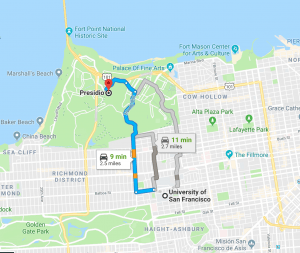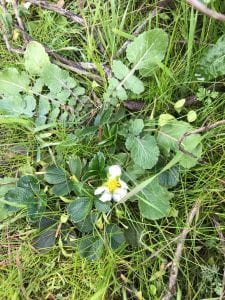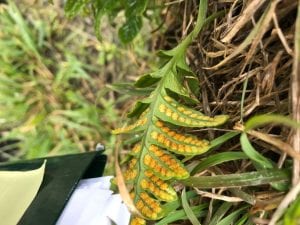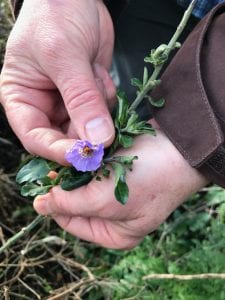The trail near the coast 37.7989° N, 122.4662° W
Presidio, San Francisco, CA 94129
The presidio of San Francisco is a park and former military fort on the northern tip of the SF peninsula and is part of the Golden Gate National Recreation Area. It was relatively a short trail compared to the one in Baltimore Canyon. The park is composed of mostly wooden area, stairs and hills with a beautiful scenery of Golden Gate Bridge and Marshall Beach. We could see some trees cut by the army on the trail and the poison oaks!! We also saw deciduous shrubs, coffeeberry, Osoberry, Toyon and many other diverse species.
Frangula californica
Frangula californica, also known as Coffeeberry, is a family of Rhamnaceae. This is the first plant we saw on the trail. It is shrub about less than 5m, and its stem is reddish brown. The leaf is generally evergreen with petiole 3-10mm, blade 20,100mm, elliptic to ovate, base acute to rounded, and tip truncate to acute. The vein is generally easy to observe. The florescence is 5-60 flowered, and pedicel less than 20mm. The flower is hypanthium 1-2mm wide. The fruit is generally 2-stoned with black color, size of around 10-15mm.
Fragraria chiloensis
Beach strawberry is a family of Rosaceae is often dioecious plant. The leaf is thick, leathery and petiole is generally 2-20cm. The blade is 10-60mm, obovate, and densely hairy. It is glabrous adaxially, rounded to truncate, rounded-obtuse. Inflorescence is exceeding leaves generally 20-40mm wide; hypanthium bractlets unlobed; sepals 6-10mm; petals 10-18mm. The flower is receptacle 10-20mm, white petals and yellow stamen in the middle. They ususally live in ocean beaches, and coastal grassland.
Polypodium californicum
Polypodium californicum, also known as California polypody is a fern that is a part of family polypodiaceae. It is summer-deciduous but it can also be evergreen depending on the climate. The blade is pinnate about 10-25cm long, The leaves are deltate to ovate, and membranous to fleshy, often firm. The interesting feature of the plant is you can see the sporangia under the leaves. The sori is yellow to orange color about 1.5-3.5mm round to ovate. They usually live in shaded canyons, streambanks, slopes, cliffs or coastal bluffs.
Narrative
We waited in the classroom for 15 minutes until the rain die down. We moved to the parking lot around 1:10pm but we got little delayed because Dr.Paul’s grad student had a hard time exiting the parking spot. It was hilarious that I thought Dr.Paul went to help him but he started taking a photo of it. It rained sporadically few times on our time on the trail and Dr.Paul started taking a video of our suffering. I should’ve smiled and pretend like the rain was nothing since we were all on his feed. The place was muddy but the hike was not as steep and difficult as we had in Baltimore Canyon. The rain didn’t bother me no more because there was a beautiful scenery of the Golden Gate Bridge and Marshall Beach on our way. I particularly enjoyed seeing Beach blue lupine, Osoberry, Arroyo willow and Blue witch. I also realized that botanists are really bad at naming since they’re nearly color blinds. Blue witch was not blue! it was purple! Since I’m not from here I never knew that I could see variety of different plants just 10 minute away from our school. It was a memorable moment and I will come back in the future when we have better weather!
More plants!
Heteromeles arbuifolia aka Toyon; Family:Rosaceae
Solanum umbelliferum aka blue witch; Family:Solanaceae

Eriophyllum staechadifolium aka Lizard tail; Family:Asteraceae





